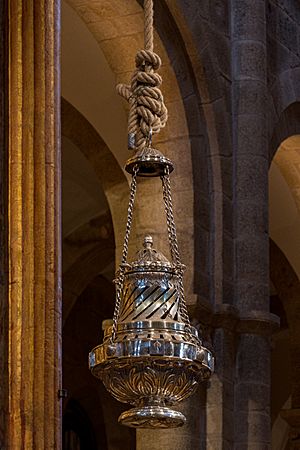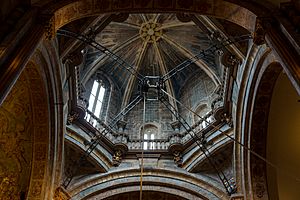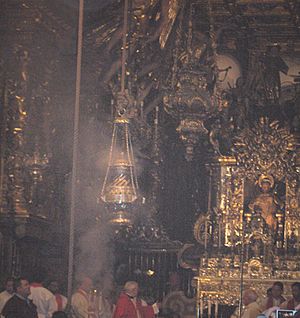Botafumeiro facts for kids
The Botafumeiro is a very famous thurible (a special container for burning incense) used in the Cathedral of Santiago de Compostela in Spain. Its name comes from the Galician language. Botar means "to throw away," and fume means "smoke."
It is a symbol of both the cathedral and the city. The Botafumeiro is known for its amazing swinging motion. This happens during the Pilgrim's Mass and other special events. It can swing very fast, reaching speeds of about 60 kilometers per hour (about 37 miles per hour). This special ritual has been happening for a very long time, since at least the 12th century.
Contents
What is the Botafumeiro?
The Botafumeiro used today is made from a mix of brass and bronze. It is covered with a very thin layer of silver, about 20 micrometers thick. This makes it look shiny and golden. A craftsman named José Losada created this Botafumeiro in 1851.
The Santiago de Compostela Botafumeiro is one of the biggest censers in the world. It weighs 80 kilograms (about 176 pounds) and is 1.60 meters (about 5 feet 3 inches) tall. Usually, you can see it in the cathedral's library. But for important religious events, like the Feast of Saint James, it is brought out. It is then attached to a rope that hangs from a special pulley system.
There is another large thurible used for other masses in the cathedral. It is called La Alcachofa (which means 'the Artichoke') or La Repollo (meaning 'the Cabbage'). La Alcachofa is made of silver-colored metal. It was made in 1971 by artists working with Luis Molina Acedo.
The Botafumeiro hangs 20 meters (about 65 feet) high. It is connected to a pulley system under the church's dome. The current pulley system was put in place in 1604. The ropes used to swing it usually last about 20 years. However, in 2004, a thicker rope wore out faster than expected and had to be replaced. Before 2004, the ropes were made from hemp or a type of grass called esparto. Now, a strong synthetic (man-made) rope is used.
The censer is given a push to start its movement. Eight men in red robes, called tiraboleiros, pull the ropes. This makes the censer swing higher and higher. The thurible almost touches the ceiling as it swings. It releases thick clouds of incense as it moves. The Botafumeiro can reach speeds of 68 kilometers per hour (about 42 miles per hour). At its highest point, it reaches about 21 meters (about 69 feet) high. It swings in a wide arc of 65 meters (about 213 feet). This big swing can be reached after about 17 swings, taking about 80 seconds.
When does the Botafumeiro swing?
The Botafumeiro officially swings on several important dates throughout the year. Many pilgrims, tourists, and visitors love to see it.
- 6 January: Epiphany
- Between 4 April and 8 May: Resurrection Sunday (Easter)
- 23 May: The Apparition of the Apostle-Clavijo
- Between 10 May and 13 June: Pentecost (50 days after Easter)
- 25 July: The Feast of Saint James
- 15 August: Assumption of Mary
- 1 November: All Saints' Day
- 20–26 November: Feast of Christ the King (Last Sunday of the church year)
- 8 December: Immaculate Conception
- 25 December: Christmas
- 30 December: Transfer of the Body of James the Apostle to Galicia
Who are the Tiraboleiros?
The Botafumeiro is moved and swung by eight men in red robes. They are called tiraboleiros. This name comes from the Galician language. It is related to the Latin word turifer, which means 'incense carrier'. This word comes from thus, meaning 'incense', and fero, meaning 'carry'. In Spanish, a similar term is turiferario.
History of the Botafumeiro
Some people believe that swinging a censer in the Santiago de Compostela Cathedral started in the 11th century. Back then, pilgrims arriving at the cathedral were often tired and not very clean. It was also thought that incense smoke helped prevent illnesses like the plague and other widespread sicknesses. Burning incense is also an important part of church services. It is seen as a form of prayer or "oration to God."
In the 13th century, the pulley system was improved. This new system allowed the Botafumeiro to swing much higher. Without this change, it would only swing about 1.5 meters (about 5 feet).
In the 15th century, King Louis XI of France gave money to the cathedral. This money was used to replace their old medieval thurible, which was made of silver. A new silver thurible began to be used in 1554. Sadly, this beautiful silver censer was stolen by Napoleon's soldiers in April 1809. This happened during the Spanish War of Independence. Because of this, the silver censer was replaced by the current one, made by Losada, in 1851.
After 155 years of use, the Botafumeiro was repaired in early 2006. Craftsmen fixed dents and cracks. They also put a new 20-micrometer-thick layer of silver on it. Many other cathedrals used to have large swinging thuribles. But over the years, most of them stopped using them.
Accidents with the Botafumeiro
Over the years, there have been a few accidents while the Botafumeiro was swinging. It seems that at one time, it was attached to the rope with a hook that sometimes came undone.
One famous accident happened in 1499. Princess Catherine of Aragon was visiting the cathedral. She was on her way to marry the prince of England. While the Botafumeiro was swinging, it flew out of the cathedral through a high window! Luckily, no one was hurt in this incident.
The ropes and other parts holding the Botafumeiro have also broken. This happened on May 23, 1622, and more recently in 1925 and July 1937. In 1622, the Botafumeiro fell at the feet of the tiraboleiros. In July 1937, the ropes broke again, and hot coals spilled onto the floor. Today, the rope is attached to the Botafumeiro using strong sailor's knots to keep it safe.
See also
 In Spanish: Botafumeiro para niños
In Spanish: Botafumeiro para niños




